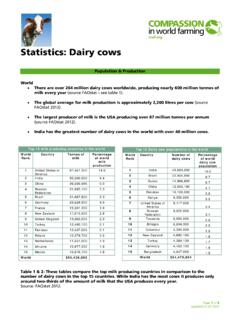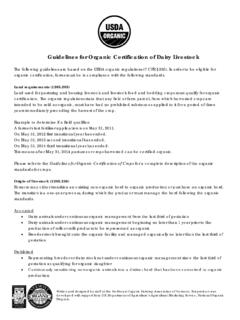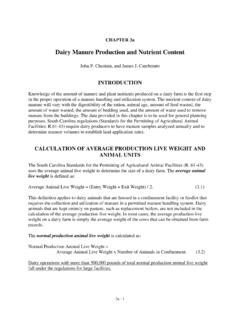Transcription of MODULE ONE Introduction to: Occupational Safety & …
1 MODULE ONE Introduction to: Occupational Safety & Health Administration Learning Objective: Upon completion of this unit you will be able to summarize the foundations and functions of OSHA as it pertains to Wisconsin dairy Farming. Learner Outcomes: You will be able to: 1. Explain the importance of OSHA, including its history. 2. Identify the rights of the employer as well as the employee when working with OSHA. Instructional Notes Begin class with PPT slide number 1 Slide 2: Objectives Slide 3: Outcomes Slide 4: Credits 3.
2 4. 5. 6. 7. Identify the components of Material Safety Data Sheets (MSDS). Interpret the information provided on the MSDS. Explain your responsibilities as an employer. Identify the record keeping requirements for employee injury and illness. Explain how OSHA inspections are conducted. Introduction to: Occupational Safety and Health Administration MODULE 1 1 Slide 5: Section One: Why is OSHA Important? Class procedures: 1. 2. 3. 4. 5. History of OSHA class discussion OSHA's mission Small group activity Fat/Cat report Importance of training Review questions Historical events leading to OSHA: Slide 6: The 1911 Triangle Shirtwaist Company fire in New York City o Killed 146 of 500 employees in one of the worst work- related disasters in our country's history.
3 O Factory workers, mainly young, female immigrants working long hours for low wages, died because doors were locked and there were no fire escapes. o This tragedy outraged the public, who called for Safety and health reform. Production for World War I caused a crisis in workplace Safety and health conditions. (1913-1919) The government created a Working Conditions Service to help states inspect plants and reduce hazards. 1930's, as part of President Roosevelt's New Deal, additional laws increased the federal government's role in job Safety and health.
4 But the federal role was mainly to provide service and information to state governments. In 1936, Congress enacted the Walsh-Healey Public Contracts Act, which barred companies with hazardous worksites from obtaining federal contracts. But the legislation applied only to specific industries, ignoring much of the public and private sectors. For the next three decades, union efforts to expand workplace Safety laws were slowed by opposition from employers, who found it cheaper to replace dead or injured workers than to create safe workplaces.
5 By the late 1950's, the Federal-State partnership could no longer deal with the growing workforce and increasing hazards. Additional federal laws were enacted, but only covered certain industries. 2 MODULE 1 Center for dairy Farm Safety - University of Wisconsin - River Falls & Wisconsin Extension Slide 7: Slide 7: Slide 8: By the 1960's, 14,000 workers died every year and more than million workers were not able to work from injuries and illnesses.
6 In 1965, the Public Health Service issued a startling report, titled "Protecting the Health of Eighty Million Americans," which found that a new chemical entered the workplace every 20 minutes, and that evidence now showed a strong link between cancer and the workplace. It also reported that old problems were far from being eliminated, and called for a major national campaign to improve Occupational health. At the urging of labor organizations, President Lyndon B. Johnson (LBJ) agreed to establish a task force to draft a proposal, but due to internal bickering, the committee was deadlocked.
7 In January 1968, LBJ declared hazardous workplace conditions a "national crisis" and submitted a Safety and health bill to Congress that charged the DOL with establishing nationwide, mandatory Safety standards. Federal inspectors would be given the authority to investigate worksites and penalize violators. Seeking support from blue-collar workers, in August 1969, newly-elected president Richard Nixon announced his support for a modified version of Johnson's proposal. Nixon's bill gave the Labor Department responsibility for workplace inspection, but called for the creation of a five- person board, appointed by the president, to establish national health and Safety standards.
8 In November 1970, the two parties reached an agreement: Congressional Republicans agreed to create a new agency the Occupational Health and Safety Administration (OSHA) which would inspect workplaces, and Democrats agreed to a separate appointed group that would review and judge cases involving industry violations. With the support of labor unions and businesses alike, President Nixon signed the bill into law on Dec. 29, 1970. On December 29, 1970, President Nixon signed the Occupational Health and Safety , or OSH Act. This Act created OSHA, the agency, which formally came into being on April 28, 1971.
9 For the first time, all employers in the United States had the legal responsibility to provide a safe and healthful workplace for employees. And, there were now uniform regulations that applied to all workplaces. The OSH Act is also known as Public Law 91-596. Introduction to: Occupational Safety and Health Administration MODULE 1 3 Covers all private sector employers and their workers in the 50 states and all territories and jurisdictions under federal authority. Employers and workers in many fields, including but not limited to manufacturing, construction, long shoring, agriculture, law, medicine, charity and disaster relief are covered by OSHA.
10 Religious groups are covered if they employ workers for secular purposes, such as maintenance or gardening. OSHA was established to: Slide 10 - 11: Reduce work place hazards and implement new or improved methods for work place Safety and health Provide research data Maintain a recordkeeping and reporting system to monitor job related injuries and illnesses Establish training programs to increase the number and competence of the Occupational and Safety personnel Establish separate but dependent responsibilities and rights for employers and employees Develop mandatory job Safety and health standards Provide for development, analysis.















